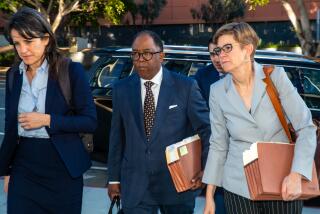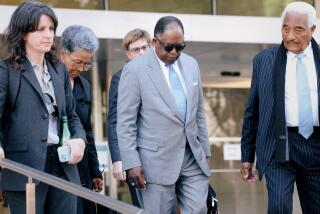Jury Query Reveals a Gray Area of the Law
- Share via
The issue raised by jurors in the Arthur Andersen case Thursday--can the firm be convicted if they disagree about who at the firm is guilty?--is unsettled, with legal experts divided on the question.
U.S. District Judge Melinda Harmon left the bench Thursday without answering the question, saying she needed to research the issue.
“This is a gray area,” said Laurie Levenson, a former federal prosecutor and a professor at Loyola Law School. “I am unaware of a case that directly answers this question for the court.”
The jurors’ question stems from instructions Harmon gave them June 5. They were told that to find Andersen guilty, prosecutors had to prove that “each of the elements of the offense ... was committed by one or more agents of Andersen, acting within the scope of their employment with the firm.”
Harmon went on to tell jurors that if “an agent, such as a partner of Andersen, acting within the scope of his or her employment, improperly induced, or attempted to improperly induce, another employee or partner of the firm or some other person to withhold, alter, destroy, mutilate or conceal an object, and that the agent did so with the intent, at least in part, to subvert, undermine or impede the fact-finding ability of an official proceeding, then you may find Andersen committed the first element of the charged offense.”
One of the notes jurors sent Harmon in their eighth day of deliberations sought clarification. “If each of us believes that one Andersen agent acted knowingly and with a corrupt intent, is it for all of us to believe it was the same agent?” the note said. “Can one believe it was agent A, another believe it was agent B, and another believe it agent C?”
Because the law is so unsettled, the answer could be up to Harmon, said Leslie D. Corwin, a partner at Greenberg Traurig and the author of a book on the law of limited liability partnerships, such as Andersen.
“This is really virgin territory,” he said. “It’s really going to boil down to what her interpretation of the indictment is. It’s not a simple question.”
Generally, the jury must find that there was an individual acting with “corrupt intent” and must agree on who that individual is, said John C. Coffee, a Columbia University law professor.
But Robert Weisberg, a criminal law professor at Stanford University, said he believes the law does allow jurors to reach a conviction without agreeing on who committed the misdeeds.
The language of model jury instructions in corporate liability cases suggests jurors need not agree on who committed the misdeeds in order to convict the organization, said Vincent Marella, a former federal prosecutor who now is a white-collar criminal defense lawyer in Los Angeles with Bird, Marella, Boxer & Wolpert.
Marella said jurors may be struggling with the testimony of David B. Duncan, a fired partner who pleaded guilty and testified for the prosecution. On cross-examination, Duncan testified that he did not initially believe that he broke any laws by shredding documents, many of which were on file in duplicate elsewhere.
“What the jury may be doing is focusing on Duncan as if he were charged,” Marella said. “That may give rise to the question, ‘We didn’t think Duncan did anything wrong--can we still find them guilty?’ ”
In spite of the lack of law on the issue, Loyola’s Levenson said the court could take guidance from criminal conspiracy cases in which jurors might not agree on every element of the crime.
“There could be a dispute over exactly how the crime was committed,” she said. “But it’s still a valid verdict if they agree the crime was committed.”
Times staff writer Jerry Hirsch contributed to this report.
More to Read
Inside the business of entertainment
The Wide Shot brings you news, analysis and insights on everything from streaming wars to production — and what it all means for the future.
You may occasionally receive promotional content from the Los Angeles Times.











